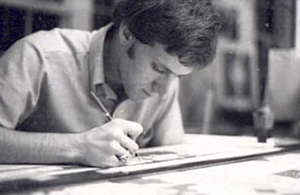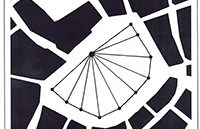A Legacy in Design: Honoring the Siena Emblem

Kem Hinton, right, is presented with his Siena Society recognition piece from Dean Jason Young at the college's 60th anniversary gala.

In 1972, Kem Hinton, FAIA, (‘77) noticed a plan drawing of Siena’s Piazza del Campo on programs, awards, publications, and doorways at the New School of Architecture. He had just enrolled in the five-year curriculum.
“It was on everything and everywhere, and even though most of us had no idea what it was,” he said. “It was the symbol of the spirited program, and my fellow students and I would often include the logo on our presentation drawings. Only later would we learn of its origins.”
The emblem was established under the founding dean, Bill Lacy, as a school logo and distinctive graduation ring for the inaugural class in 1969, still available to this day. Lacy selected the piazza image as the best example of architecture having become a formal profession during the Renaissance.
 Since the school’s founding in 1965, the College of Architecture and Design now includes graphic design, interior architecture, and landscape architecture. The disciplines have expanded Hinton’s appreciation for the Siena emblem’s symbolism more the ever.
Since the school’s founding in 1965, the College of Architecture and Design now includes graphic design, interior architecture, and landscape architecture. The disciplines have expanded Hinton’s appreciation for the Siena emblem’s symbolism more the ever.
“Ironically, this diagram can now be seen to represent all four design programs. And by again embracing and using the fascinating logo, it will amazingly link the past to the present and the future,” he said.
Forming Foundations at UT
Growing up in Murfreesboro, Tennessee, Hinton was introduced to architecture by his high school art teacher.
“I had some talent that was evident when I was in high school, and I always like to draw,” he said. “I really wanted to design motorcycles and psychedelic posters. Fortunately, my teacher, Jean Craig, introduced our class to the many types of art, including that most ancient form of architecture.”
Hinton enrolled and became part of 100 first-year Volunteers studying pre-architecture. He was formally accepted into the program during his sophomore year. Although the school occupied three older buildings, the students developed close relationships with each other and their faculty.
“Like most, I was immersed in the curriculum.” he said. “Most of my design studio classes were in rickety Estabrook Hall, but I loved the place.”
His dedication and talent in design did not go unnoticed. He was named a recipient of the AIA Tennessee Henry Adams Student Medal, one of the highest academic honors given to architecture students. He also received a design commendation from the Society of American Registered Architects and earned a special mention from the National Institute for Architectural Education.
Along with his accolades in the field, Hinton’s campus involvement in the Summer Orientation Assistant program, Issues Speaker Committee, Student Judicial Board, and Sigma Chi Fraternity garnered him recognition as a Torchbearer, the university’s highest undergraduate honor, awarded for exemplary leadership and service.
Crafting a Career
Following graduation, Hinton returned home to Middle Tennessee to begin his career as an intern with Nashville’s Gresham Smith & Partners. This internship experience, alongside his part-time work during college at the Tennessee Valley Authority’s architectural branch, allowed him to complete his professional exams only two years after graduation.
Driven by a desire to broaden his perspective and refine his skills, Hinton was accepted into the University of Pennsylvania’s Master of Architecture program in 1980. He had long admired mid-century architect Edwin Keeble, a 1928 Penn graduate best known for designing Nashville’s landmark 1957 L&C Tower, at that time the tallest skyscraper in the South.
“I was already a registered architect when I arrived at Penn,” he said. “The Ivy League school was full of world-renowned professors, and although I was in stiff competition with bright students from all over, I could hold my own. I know that was due to the strong UT bachelor of architecture curriculum.”
The program provided Hinton the opportunity to study in Paris at the Ecole des Beaux-Arts where he completed his degree in 1981.

Following the time abroad, Hinton returned home to his girlfriend, Marilyn Mabry (’76), a Nashville native and mathematics alumna who was a network planning engineer with South Central Bell. A member of the Tri Delta Sorority, Mabry had also treasured her time at UT. The pair were married in the spring of 1982.
Hinton rejoined Gresham Smith as an architect for three years before collaborating with Seab Tuck and fellow alumnus Gary Everton (’76) to launch their own firm, Tuck-Hinton-Everton Architects.
One of the firm’s early projects was Riverfront Apartments, a residential complex on property against the Cumberland River. Once a defunct ironworks shed, it was transformed into a unique housing facility with covered parking.
“Because it represented an advocacy to preserve and use old industrial structure, it was published all over the world,” he said.

The project was displayed at the 1987 World Congress of International Union of Architects in Brighton, England, and Hinton was invited to present the firm’s work at the prestigious Architectural League of New York. Riverfront Apartments received regional, national, and international awards, and the still-young firm was off to a great start.
After five years, Everton left to start his own venture, EOA Architects.
Throughout their careers, Hinton and Tuck were commissioned for many significant projects in Tennessee including the Frist Museum of Art, MTSU Sports Hall of Fame, Girl Scout Center, TSU Campus Center, Vanderbilt University’s Admissions Building, Tennessee Valley Unitarian-Universalist Church, and Nashville Public Square.
The pair were especially honored to design the Country Music Hall of Fame & Museum, one of Nashville’s most iconic landmarks due to its standout presence and intentional symbolism honoring this unique form of American music. Similarly, their Tennessee Bicentennial Mall is a large urban park north of the State Capitol, full of educational and symbolic elements to celebrate the land, people, and music of the Volunteer State.
Also located in the mall is Hinton’s single most meaningful commission, the Tennessee World War II Memorial.
“I was so fortunate to work with WWII vets on creating this commemorative destination. Sadly, all of them are now gone,” he said.
Two modest interior projects also remain special to Hinton due to their donors—The Civil Rights Room and the Votes for Women Room—both located in Nashville’s main public library. These spaces honor long-suffering justice movements and aim to educate and encourage civic engagement.
“We have always attempted to create places that educate and, if we are able, inspire,” Hinton said.
He has also served as lead designer of the new Tennessee State Library and Archives, a 165,000 square foot landmark. Situated at the northeast edge of Bicentennial Mall, it houses the state’s mammoth literary collections, and its exterior features stainless steel panels showcasing the state’s fascinating symbols.
Recognized for his professional creativity, Hinton was inducted early in his career into the National AIA College of Fellows in 1998. That same year, the state’s 100th General Assembly honored his work on Bicentennial Mall. In 2011, the park received the APA’s “Great Places in America” Award. In 2019, Hinton received AIA Tennessee’s top honor, the William Strickland Lifetime Achievement Award.
After their extremely successful 35-year run, Tuck retired and Hinton left to launch KH Design. Their namesake firm was sold and renamed.
“We are pleased that our creativity, ideas, projects, leadership, and civic contributions will be remembered and appropriately honored.”
Hinton continues his creative pursuits in architecture and urban design. He was appointed to the Tennessee Historical Commission, and he has authored books including Tennessee’s Bicentennial Mall and the upcoming nonfiction Nether Land about the life and unsolved murder of a fellow UT graduate.
Commemorating the Past and Inspiring the Future
Hinton’s advocacy for the return of the school’s original, historic emblem aided the naming of a new giving community, the Siena Society, a group of alumni and friends who are all in for the college through their exceptional generosity and the pivotal role they’ve played in shaping the college’s trajectory.
With the recent establishment of two estate gifts from Hinton and his wife totaling $1 million, their funds will provide student scholarships and faculty awards in commemoration of the Siena emblem.
“We can’t wait to see who receives these in the coming years,” the pair said.

Hinton and 22 other generous alumni and friends were inducted into the inaugural class of the fundraising Siena Society at the college’s 60th anniversary celebration in April.
In hopes that more of the college’s community feels a connection the Siena emblem’s history, Hinton expanded his generosity this spring, providing a gold lapel pin bearing the design to the Class of 2025.
“Providing those insignias honors my past professors, fellow students, and the legacy of Dean Bill Lacy. I hope the new grads will cherish the small item as all of us welcome them into a heritage now spanning six decades.”
Hinton continues to wear his class ring and hopes that the next generation of Volunteers from the college will also invest in one.
“It always draws attention, and then I explain its rich meaning,” he said. “I am overjoyed that Dean Jason Young has recognized the value of the Siena emblem. I especially look forward to seeing its renewed use. To my knowledge, ours is the only educational institution of architecture in the nation that possesses an official symbol. There may be others, but ours is the finest!”